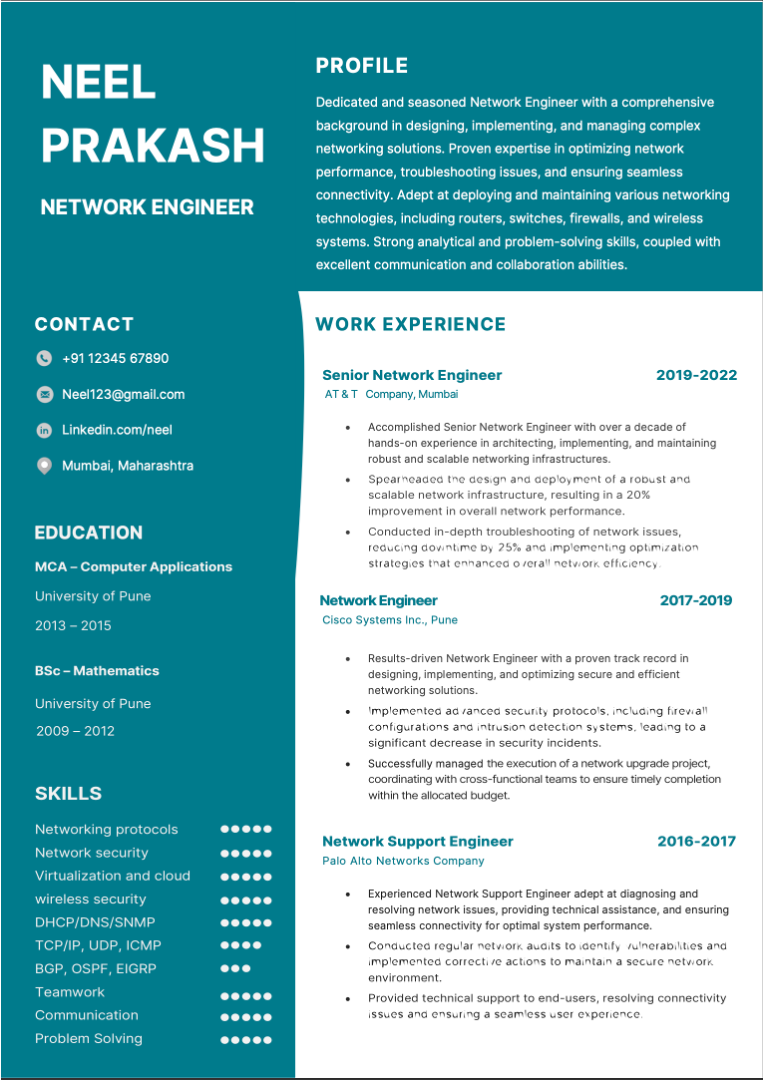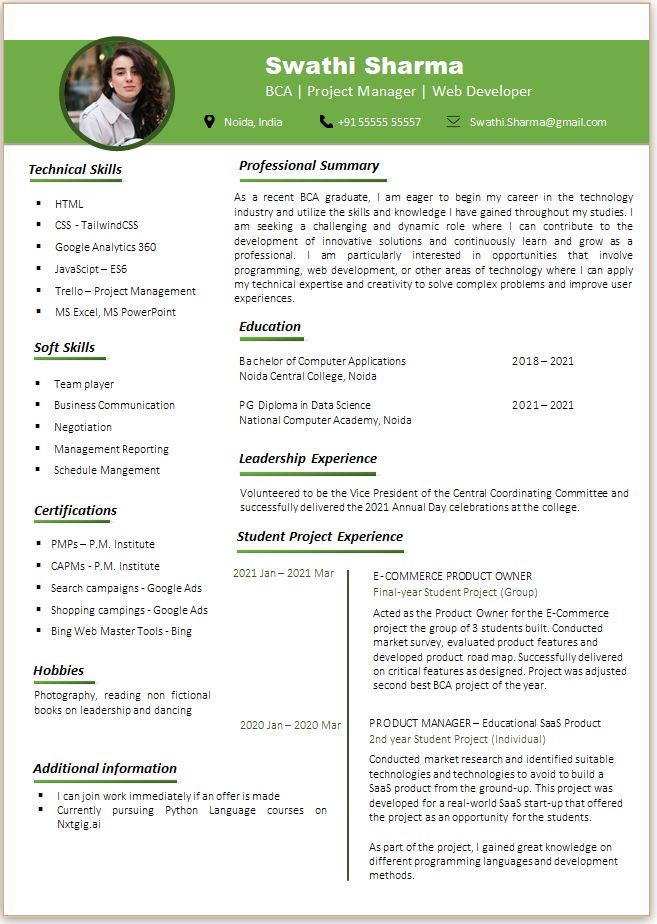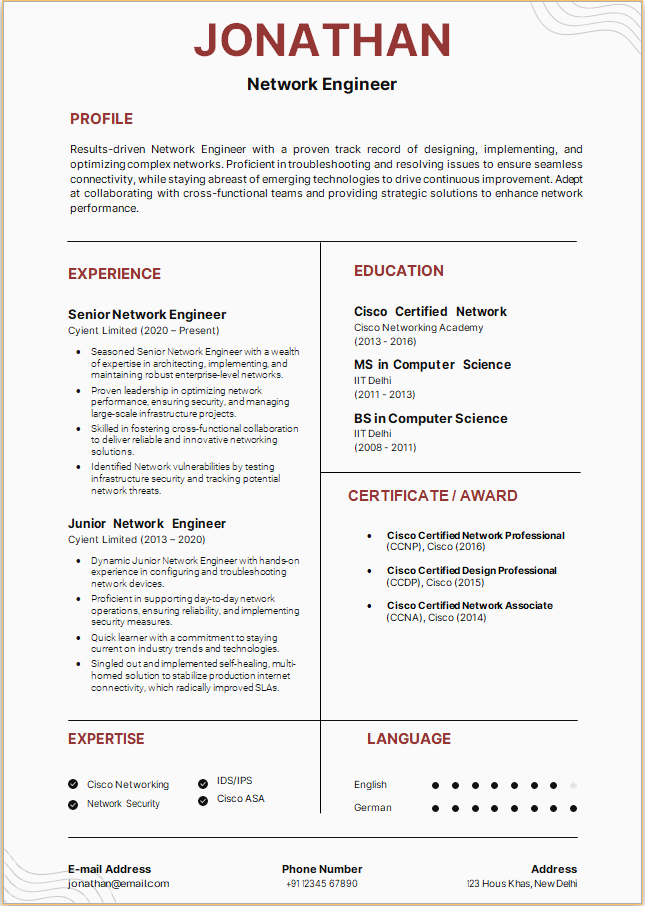Modern Resume
MCA Network Engineer Sample Resume
Network Engineer Sample
netEng1

Objective
Dedicated and seasoned Network Engineer with a comprehensive background in designing, implementing, and managing complex networking solutions. Proven expertise in optimizing network performance, troubleshooting issues, and ensuring seamless connectivity. Adept at deploying and maintaining various networking technologies, including routers, switches, firewalls, and wireless systems. Strong analytical and problem-solving skills, coupled with excellent communication and collaboration abilities.
Education
University of Pune
Master of Science in computer engineering
2013 – 2015
University of Pune
Bachelor of Science in computer engineering
2009 – 2012
Skills
• Networking protocols • Network security • Virtualization and cloud • wireless security protocols • DHCP/DNS/SNMP • TCP/IP, UDP, ICMP • BGP, OSPF, EIGRP
Experience
Senior Network Engineer 2019-2022
AT & T Company
• Accomplished Senior Network Engineer with over a decade of hands-on experience in architecting, implementing, and maintaining robust and scalable networking infrastructures.
• Spearheaded the design and deployment of a robust and scalable network infrastructure, resulting in a 20% improvement in overall network performance.
• Conducted in-depth troubleshooting of network issues, reducing downtime by 25% and implementing optimization strategies that enhanced overall network efficiency.
Network Engineer 2017-2019
Cisco Systems Inc.
• Results-driven Network Engineer with a proven track record in designing, implementing, and optimizing secure and efficient networking solutions.
• Implemented advanced security protocols, including firewall configurations and intrusion detection systems, leading to a significant decrease in security incidents.
• Successfully managed the execution of a network upgrade project, coordinating with cross-functional teams to ensure timely completion within the allocated budget.
Network Support Engineer 2016-2017
Palo Alto Networks Company
• Experienced Network Support Engineer adept at diagnosing and resolving network issues, providing technical assistance, and ensuring seamless connectivity for optimal system performance.
• Conducted regular network audits to identify vulnerabilities and implemented corrective actions to maintain a secure network environment.
• Provided technical support to end-users, resolving connectivity issues and ensuring a seamless user experience.
Additional Inputs
Most Common Interview Questions for Network Engineering Positions
HHere are five common interview questions for experienced candidates in networking engineering, along with sample answers:
Question:
Can you explain the differences between TCP and UDP? When would you choose one over the other in a networking scenario?Sample Answer
TCP (Transmission Control Protocol) and UDP (User Datagram Protocol) are both transport layer protocols, but they have distinct differences. TCP is a connection-oriented protocol that ensures reliable, ordered, and error-checked delivery of data. It is suitable for applications where data integrity and order are crucial, such as file transfers and web browsing. UDP, on the other hand, is connectionless and provides faster but less reliable data transmission. It is suitable for real-time applications like streaming and online gaming, where low latency is more critical than perfect data delivery.
Question:
Explain the concept of subnetting. Why is it important in networking, and how does it contribute to efficient IP address management?Sample Answer
Subnetting is the process of dividing an IP network into sub-networks to enhance performance and security. It allows for efficient utilization of IP addresses and helps in the logical grouping of devices. Subnetting also reduces network congestion and improves overall network performance. By breaking down a large network into smaller subnets, administrators can better manage IP address assignments, control broadcast domains, and implement security measures more effectively.
Question:
What is the purpose of VLANs (Virtual Local Area Networks) in networking, and how do they work? Provide an example of a scenario where VLANs would be beneficial.Sample Answer
VLANs are used to logically segment a physical network into multiple virtual networks, improving network performance, security, and management. They operate at the data link layer and separate broadcast domains. For example, in a company with different departments (e.g., finance, marketing, and IT), VLANs can be used to isolate network traffic for each department. This enhances security by restricting communication to within the VLAN, and it allows for more efficient bandwidth utilization.
Question:
Can you explain the role of routing protocols in a network? Provide examples of popular routing protocols and their characteristics.Sample Answer
Routing protocols are essential for routers to determine the best path for forwarding data between networks. Examples of routing protocols include RIP (Routing Information Protocol), OSPF (Open Shortest Path First), and BGP (Border Gateway Protocol). RIP is a distance-vector protocol suitable for small networks, OSPF is a link-state protocol ideal for larger networks, and BGP is used for routing between autonomous systems on the internet. Each protocol has its own advantages and is selected based on factors like network size, complexity, and scalability requirements.
Question:
How do you troubleshoot network performance issues? Can you provide an example of a challenging network problem you've successfully resolved in the past?Sample Answer
Troubleshooting network performance involves a systematic approach, including checking physical connections, analyzing network traffic, and utilizing network monitoring tools. In a previous role, we experienced intermittent connectivity issues. After conducting a thorough analysis, I discovered a faulty network switch. Replacing the switch resolved the problem, and implementing regular network monitoring helped prevent similar issues in the future. Troubleshooting also involves collaborating with team members, documenting findings, and continuously updating network configurations to optimize performance.
Remember, these sample answers are just examples, and candidates should tailor their responses based on their own experiences and knowledge. Additionally, interviewers may ask follow-up questions to assess the depth of a candidate's understanding and problem-solving skills.


